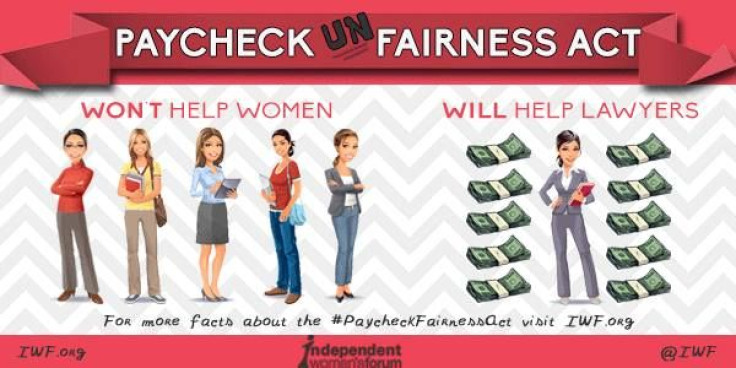Equal Pay Day 2014: Wage Gap Debate Hits Fever Pitch, Sparks Backlash, As White House Pushes Paycheck Fairness Act
Both sides of the debate came out swinging on Tuesday, but is either side listening?

If you’ve been paying attention to political sound bites the last few months, you’ve no doubt heard the statistic that women make 77 cents for every dollar that men make. And depending on your political leanings, you’ve probably had one of two reactions to said statistic: Either you’re angry that gender-based pay discrimination has remained so stubbornly persistent over the last few decades, or you’re angry that the “misleading” 77 percent gap is being taken at face value. In either case, the operative word is “angry,” an adjective that sums up America’s clamorous discourse on equal pay in the 21st century.
To mark Equal Pay Day 2014, both sides of the debate came out swinging on Tuesday. Economists Mark J. Perry and Andrew G. Biggs threw down the gauntlet in a Wall Street Journal op-ed, calling the 77 cent statistic a “myth” and saying the gender wage gap “all but disappears” once variables like education, marital status and occupations are factored in. Jillian Berman, a business reporter for the Huffington Post, quickly shot back. “There is a very real gulf between how much money women and men make,” she wrote. “That gender wage gap cannot be argued away.”
It’s the kind of deliberation that has ensued, to some extent, every year since 1996, when Equal Pay Day was first launched by the National Committee on Pay Equity. But it’s particularly pronounced this year. In part, that’s because Democrats are using the occasion to drum up support for the long-stalled Paycheck Fairness Act, which is coming up for a Senate vote despite having already failed to pass on two separate occasions. The act, in a nutshell, would amend the 1938 Fair Labor Standards Act with provisions aimed at strengthening enforcement tools. For instance, the law would a prohibit employers from retaliating against workers who discuss their salaries with other employees.

The bill has broad support from Democrats and civil rights groups like the ACLU, but conservatives have been pushing back. The Republican National Committee on Monday issued a press release calling the act a “desperate political ploy” to curry favor with women voters in an election year. Since gender-based wage discrimination is already illegal -- and has been since the Equal Pay Act of 1963 -- the new law would only pile on another layer of redundant regulations and open up employers to an avalanche of frivolous lawsuits, Republicans argue.
Not so, says President Obama, who, in addition to pushing the Fair Paycheck Act, is also marking Fair Pay Day with two new executive actions that will strengthen enforcement of equal pay laws for federal contractors.
But some of Obama’s critics, including the aforementioned Mark J. Perry, say the president should practice what he preaches. In September, Perry put out a study showing that female White House staffers make 88 percent of what their male counterparts make.
SMOKE & MIRRORS: By the President's own standards, women make 88 cents to a man's dollar in his White House. #PaycheckFairness #crnc
- Alex Smith (@AlexandraCSmith) April 8, 2014In an interview with CNN on Tuesday, Jay Carney, the White House press secretary, addressed the study. “That is not 100 but it’s better than the national average,” he said, evoking snickers from CNN commentators.
A Numbers Game
Aside from the fringiest of orators, few would argue that no pay gap exists. But the size of the disparity is undoubtedly subject to interpretation, depending on how you do the math. The oft-cited 77 cents statistic comes from the U.S. Census Bureau, which has reported that the annual median pay for women is about 23 percent lower than the median pay for men. Those parameters are admittedly broad, factoring in the midpoint for all jobs in all industries, not women and men performing comparable jobs, as FactCheck.org pointed out in 2012. The statistic’s lack of context has only served to embolden critics of the Fair Paycheck Act. Groups like the right-leaning Independent Women’s Forum have been having a field day with it, calling it a “pretext for more government intrusion into the work place.”

But such arguments negate the fact that the pay gap is real and persistent, even if the 77 cents doesn’t tell the whole story. And amid the rhetoric and extremes, it’s easy to forget that there is a middle ground, and perhaps even a consensus. According to Pew Research, which looked at hourly earnings of both full- and part-time workers, women earned 84 percent of what men earned in 2012. That result was comparable to statistics released a few months earlier by the U.S. Bureau of Labor Statistics, which found that women earned 81 cents on the dollar.
In both studies, the pay gap is also shown to be narrowing -- it was 36 percent in 1980, according to Pew, compared to 16 percent today. While encouraging, the news may not bode well for the Twitter hashtag #NoMadMenPay, a reference to 1960s-era wage disparity, which made the rounds on Tuesday. According to the National Committee on Pay Equity, we’ve come a long way since 1963, when the pay gap was a staggering 59 percent.
For more on that, watch Pew Research’s video on the gender pay gap below.
Got a news tip? Email me. Follow me on Twitter @christopherzara.
© Copyright IBTimes 2024. All rights reserved.












